#george smathers libraries
Photo
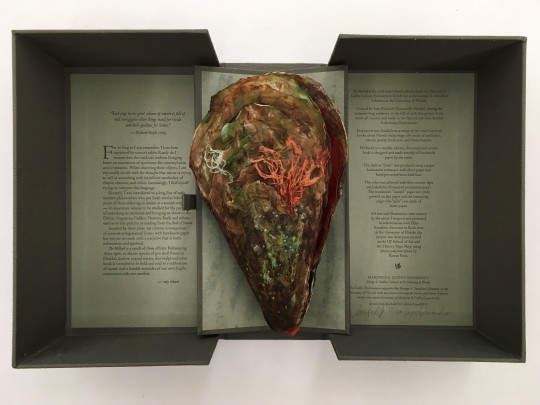
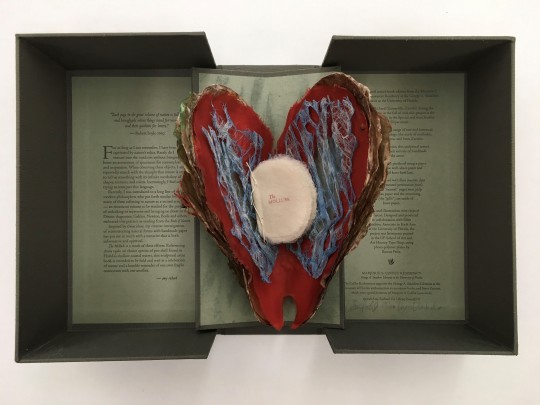
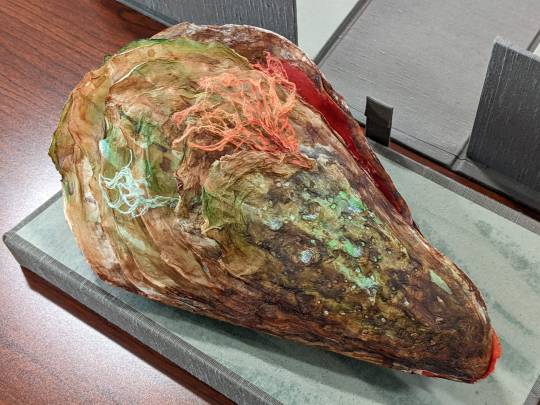
“Referencing Atrina rigida, an elusive species of pen shell found in Florida's shallow coastal waters, this sculptural artist book is intended to be held and read as a celebration of nature and a humble reminder of our own fragile connection with one another.
The Mollusk is the 2018 artist's book edition from the Marjorie S. Coffey Library Endowment Residency at the George A. Smathers Libraries at the University of Florida. The book was created by Amy Richard during the semester-long residency in the fall of 2018. This project is the result of research and study in the Harold and Mary Jean Hanson Rare Book Collection in the Special and Area Studies Collections Department. Inspiration was found from a range of rare and historical books about Florida malacology (the study of mollusks), nature, poetry, book arts and livres d'artiste.
Produced as a variable edition, this sculptural artist's book is designed and made entirely of handmade paper by the artist. The shell serves as a "cover" and was produced using a paper lamination technique with abaca paper and hand processed kozo bark lace. Inside the shell between the layers of translucent "mantel" pages, pulp printed on flax paper, are the "gills", made of kozo paper.”
--artist’s statement
(more at The Mollusk by Richard, Amy Koski, 1962- Library Press@UF, 2018 · Special Collections and Archives)
#bookarts#paper arts#artists book#artists books#mollusk#rare books#rarebooks#special collections#specialcollections#mizzou#university of missouri#libraries#fb#kelli h
50 notes
·
View notes
Text




Books on the Johns Committee in Florida and the Lavender Scare
These were the books that gave me the further research and access of understanding how the Johns Committee came about. Very highly resourceful of understanding the homosexual purges that occurred at UF.
#johns committee#university of florida#florida state university#university of south florida#research#cold war#mccarthyism#lavender scare#books & libraries#george smathers libraries
1 note
·
View note
Photo

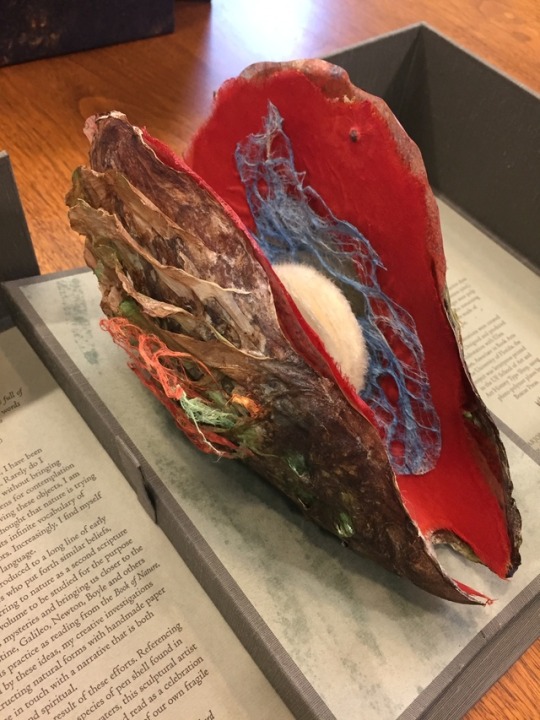

We are mesmerized by The Mollusk 🐚 (2018), a handmade artist’s book in our American Art/Portrait Gallery Library by Amy Richard. Richard was inspired by Florida malacology books and created this edition during a residency at the George A. Smathers Libraries at the University of Florida.
Interested in more artists’ books? We have over 1,000 in our collections. Check out the Artists’ Books portal on our webpage.
1K notes
·
View notes
Text
Island Grove, Florida
By Joanna Grey Talbot
A few minutes down the road from Cross Creek at the intersection of Highway 301 and County Road 325 is another small town with a fascinating history.
Island Grove was established in the early 1880s and its post office was opened on February 17, 1884. The town had a school house, two churches, a grocer, and a railroad stop. By the 1890s the town grew to 400 residents.
The town’s two main industries were citrus and fishing. A large citrus packing house operated in Island Grove and produced 10,000 crates of oranges a season at its height. Until the devastating freezes of the late 1890s the town remained a shipping center for oranges and vegetables.

Alfred E. Warden in an Island Grove okra patch, courtesy of the State Library and Archives of Florida
Fisherman pulled their stock from the nearby Orange Lake and Lochloosa Lake. In 1892 the company of Weeks & Lambeth built a moss factory and ginned 20 bales a day. Spanish moss was used for a variety of products, including stuffing mattresses.

A celery field in Island Grove, 1940s, courtesy of the University of Florida Archives, Special Collections, George A. Smathers Libraries
According to the Works Progress Administration (WPA) records, Island Grove Baptist was constituted and opened its first building in 1902. The congregation met every third Sunday until they found a permanent pastor. Reverend Ben York was appointed the first pastor and he served from 1902-1904. In the 1930s when the WPA recorded this information the congregation at that time totaled 85.
The Island Grove Masonic Lodge No. 25 was founded in 1924 but today is inactive.
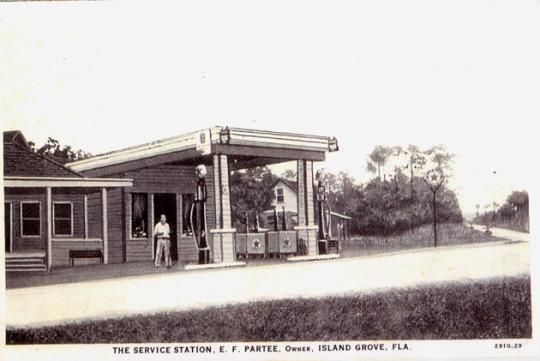
The Service Station, owned by E. F. Partee, courtesy of the Matheson History Museum
Island Grove’s historic cemetery, Antioch Cemetery, held it’s first burial on July 4, 1871, for an infant from the Vandlandingham family, according to the Alachua County Virtual Cemetery Project. The cemetery is also the final resting place of Pulitzer Prize-winning author Marjorie Kinnan Rawlings and her husband, Norton Baskins. If you visit her grave today you can easily find it by looking for the fake deer that rest next to her tombstone, an homage to her novel The Yearling, and the collection of pens and pencils.

Marjorie Kinnan Rawlings headstone, 2012, courtesy of Joanna Grey Talbot
Today Island Grove is most well known for the Island Grove Wine Company, which opened in 2010 and specializes in fruit wines (blueberry, blackberry, peach, apple, and more). Their tasting room is located at the intersection of Highway 301 and County Road 325. The town also hosts the Island Grove Blueberry Festival, which started in 2007. Its held annually in the spring.
Island Grove may be another town that if you blink you’ll miss it but if you slow down you just might find a treasure.
1 note
·
View note
Photo

… una ventana! (at University of Florida George A. Smathers Libraries) https://www.instagram.com/p/CVLzjNtlOVL/?utm_medium=tumblr
0 notes
Text

SANIBEL CAPTIVA HISTORY
Kinzie Brothers Steamer Line Ferry Pass - Car and Party to and from Sanibel Island (via University of Florida George A. Smathers Libraries). Our grandparents used one of these passes to come to Sanibel for the first time in the 1950s.
The ferry’s last voyage took place on May 26, 1963, coincident with the opening of the Sanibel Bridge and Causeway.
It all started in 1904 when George F Kinzie and Andrew L. Kinzie, brothers of a Lee County pioneer family, started operating a freight and excursion steamer business in Fort Myers. Their steamers made their way down the Caloosahatchee River to the islands carrying freight, starting island produce on its way to northern markets, and carrying passengers.
https://sellingsanibelcaptiva.com/sanibel-captiva-history/f/sanibel-ferry---kinzie-brothers-steamer-line
#sanibel #captiva #history
0 notes
Text
FamilySearch Digital Library
The Internet Archive has been my go-to source for public domain books for quite a while. It’s full of regimental histories, local histories, biographies and even genealogies. It’s a very impressive resource. Now, thanks to the FamilySearch Digital Library, I have even more options.

You will find the library in FamilySearch.org. Once you sign in, click Search then click Books. You will see a screen similar to the one above. Before you hit the search box at the top of the screen, scan down the page and see which libraries are part of this project. They include:
The Genealogy Center at the Allen County Public Library
Arizona State Library
Family History Library
Birmingham Public Library
Dallas Public Library
Historical Society of Pennsylvania
Midwest Genealogical Center
Onondaga County Public Library
St. Louis County Library
University of Florida George A. Smathers Libraries
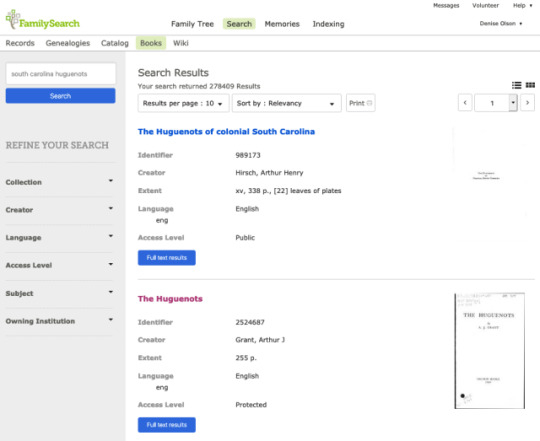
In this example, I searched for “south carolina huguenots” and got 278,409 results. You see two of them here. Notice the Access Level item for the first one is Public (Public Domain) while the second is Protected (still under copyright). There is a Full text results button under each item and in this example, a scanned title page for each. Click on the title page to view a screen with more details about the item.

Since this is a public domain publication, I have a “View All Pages 398 pages” link to open this publication for reading.

Here’s what the reader screen looks like. Use the arrow buttons to move to the next page or previous page. Notice the icons at the bottom of the screen. They offer many options. Click the box icon with a down arrow in it to download this publication. The magnifying glass icon is used to search the publication. Other icons let you zoom in or zoom out for better viewing. Hover over any icon to view its purpose.
This impressive addition to online archives is a researcher’s delight. Unlike the Internet Archive, not everything in the FamilySearch Digital Library is public domain. You may have limited access or even no access to some of the publications, but don’t let that stop you. Use the details about the publication and WorldCat.org to find a library near you where you can view that book. Happy hunting!
0 notes
Photo
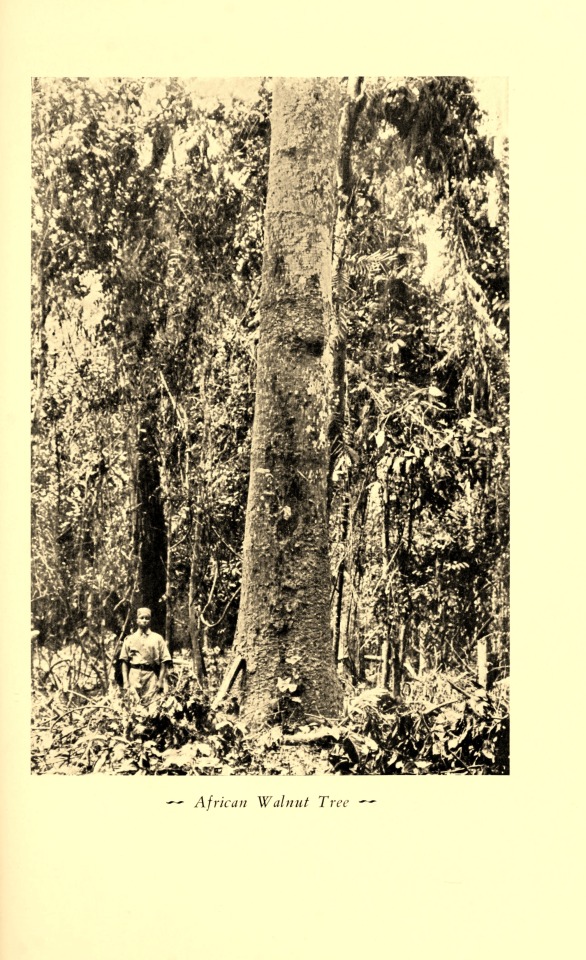

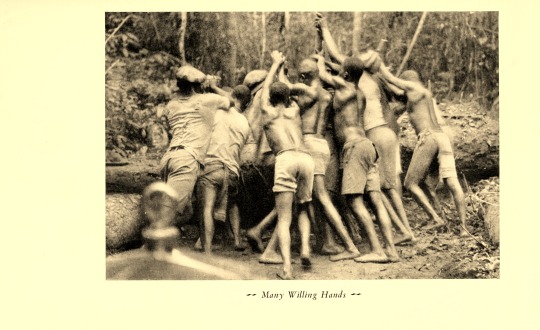



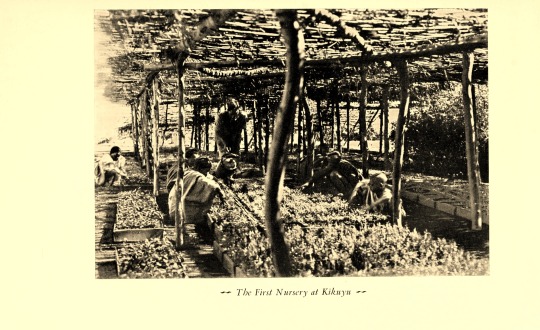


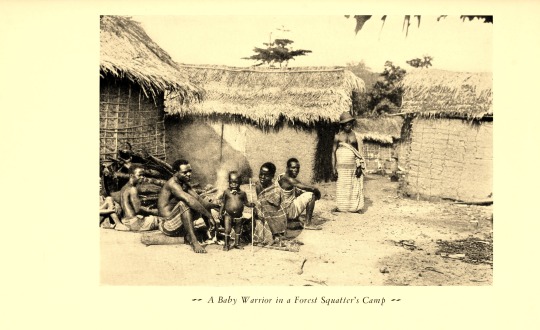
Men of the trees in the mahogany forests of Kenya and Nigeria
By Baker, Richard St. Barbe, 1889-1982
Publication info New York,L. MacVeagh, The Dial press;1931.
Contributing Library:
University of Florida, George A. Smathers Libraries
BioDiv. Library
22 notes
·
View notes
Text
UF Collections at Internet Archive
A collection of materials from the University of Florida’s George A. Smathers Library selected for the FamilySearch Library. You will find the collection on the Internet Archive.

0 notes
Text
Independent Florida Alligator, Japanese-American History, Free Music Archive, More: Friday ResearchBuzz, September 27, 2019
Independent Florida Alligator, Japanese-American History, Free Music Archive, More: Friday ResearchBuzz, September 27, 2019
NEW RESOURCES
The Independent Florida Alligator: UF Libraries complete Alligator newspaper digitization. “You can now read the words of [University of Florida] student journalists dating back to 1912. Starting today, every copy of The Independent Florida Alligator will be accessible online after UF’s George A. Smathers Libraries worked to digitize archives.”
Internet Archive Blog: What Happens…
View On WordPress
0 notes
Text
Sleep Pod Companies Want to Disrupt Naps on Campus
Around this time of the school year, it’s not uncommon to see sleep-deprived students slumped over library desks studying late hours in preparation for final exams.
As wellness and anti-stress campaigns become more popular on college campuses, some institutions are responding by giving students a more comfortable place to catch some z’s: in space age-looking sleep pods.
Already a handful of colleges and universities—and even high schools—have made room for the devices, which can go for anywhere from $8,000 to $13,000. The University of Miami, Wesleyan University, Stanford University, Washington State University and more have all debuted sleep pods in libraries, health centers and other spots on campus.
In 2017, the University of Florida installed two “EnergyPods” from Denmark-based MetroNaps, whose sleep pods were made popular after Google purchased the devices for its employees to take naps at work. Melissa L. Rethlefsen, associate dean of the George A. Smathers Libraries at University of Florida, has a clear view of the futuristic egg-shaped pods from her office in the university’s Health Science Center Libraries. The sleep chair comes with a soundtrack that is supposed to soothe parts of the brain to promote relaxation. (The jury is still out if this trendy wellness technology works beyond a placebo effect.)
“I can see people in them now,” she told EdSurge in a phone interview this week. “They are in very high demand by students.”
EnergyPods by MetroNaps (Image credit: MetroNaps)
Rethlefsen said the pods were brought in to supplement a suite of wellness initiatives the campus offers to help students relax and promote mental health. “There is a major challenge among health science students with severe burnout and depression and mental health issues,” she said. “We see the library as a place to promote wellness and wellbeing, a place of rejuvenation, and this is one of the ways we try to provide that service.”
We see the library as a place to promote wellness and wellbeing, a place of rejuvenation, and this is one of the ways we try to provide that service.
Melissa L. Rethlefsen, University of Florida
Similar rationale is used to justify the pricey nap spaces over at Texas A&M University at Corpus Christi. Franklin Harrison, director of recreational sports, goes as far to say there is a “sleep crisis” on campus and that health experts were looking for ways to promote sleep health when they purchased their own tubular sleep device in 2014.
“From a holistic wellness standpoint, we look at some of the latest issues on campus with sleep deprivation,” says Harrison. “It’s not thought about enough when you talk about class performance or athletic performance when you think about the overall well-being of a student.”
Students at Texas A&M sign-up to reserve the sleep pod for 30-minute or 1-hour naps, and officials can see that data to monitor how often and when the devices are being used. Harrison said around 57 students used the pod last semester, and those users often returned for multiple sessions.
For all the hype, many people aren’t shy to critique the high cost of these devices, and question whether purchasing these expensive gadgets skirt underlying issues around why students are sleep deprived in the first place.
At the University of California, Los Angeles, a proposal to buy up to 11 sleep pods to campus was shot down after students deemed the device—which was estimated to cost in total between $30,000 and $45,000 to purchase and install—to be not financially unfeasible.
“That money wouldn’t be used as efficiently as it could be,” one student told the Daily Bruin.
Another sleep pod company on the horizon is hoping to address cost concerns by dropping sleep pods onto campuses for free—and instead rely on a paid advertising model.
San Diego, Calif.-based HOHM looks more like a tiny bedroom than a sleep pod. The 43.5 square-feet “devices” come equipped with a twin-sized bed, chargers, privacy curtains and a tablet. According to CEO Nik Woods, the plan is to give colleges and universities up to four sleep stations for free, and for each student to receive two free hours per month to snooze. Anything beyond that schools or students have to pay for.
Exterior and interior of HOHM sleep pods (Image credit: HOHM)
His plan is to rely on corporate advertisers to foot the bill. Companies like Tempur-Sealy might plant their mattress in the pod, he explained, and students can look on the tablet for information about the products they are using. “We give them a taste of a product and ideally they like it and want,” Woods said.
The CEO said HOHM will not share students’ emails, which are used to sign up for sessions in the sleep pod, with its corporate partners. But students will likely receive a follow-up thank you email that would include information about the products in the room.
Like its sleep pod competitors, HOHM is targeting co-working spaces and corporate offices, alongside colleges and universities. And the company is set to deploy its first pod at the University of Arizona this December. That might come as a surprise to students, though. When EdSurge contacted the student body president to ask about the pods, she said it was the first time she heard they are heading to campus.
By having a closed door, HOHM’s sleep pod avoids another concern Rethlefsen, the associate dean at University of Florida, said students have about the sleep chairs: “Some people don't feel comfortable being that relaxed in a public space.”
In her previous role at the University of Utah, she said officials were looking into the sleep pods but decided against it after concerns that covering students’ heads but leaving the rest of their body and belongings exposed could leave students vulnerable to assault or theft.
What HOHM may not be able to get over, however, is a perceived gross factor. Both Harrison and Rethlefsen say the most common complaint they hear from students is fear that the devices are dirty or unhygienic, even though the pods at both universities are cleaned regularly.
That concern appears off-campus as well. After the JetBlue terminal at John F. Kennedy International Airport introduced sleep pods, the New York Post reported that cleanliness was one major reason why some travelers wouldn’t try it.
Still, Harrison stands by the pods. “Critics would say it’s a bandaid solution, but… if you can make people realize that sleep plays a key role in brain function, then it’s done it’s job. I will take the criticism if we are making a difference.”
Sleep Pod Companies Want to Disrupt Naps on Campus published first on https://medium.com/@GetNewDLBusiness
0 notes
Photo

The Baldwin Library of Historical Children’s Literature in the Department of Special Collections at the University of Florida’s George A. Smathers Libraries contains more than 130,000 books and periodicals published in the United States and Great Britain from the mid-1600s to present day. Other strengths and distinctions of the Baldwin Library include: marginalia and inscriptions, the Hans Christian Andersen Awards Collection, Little Golden Books, religious tracts, and illustrated editions from the Golden Age of Children’s Literature.
permissions
0 notes
Text
Photography exhibit celebrates 50th anniversary of Dian Fossey's gorilla research center
University of Florida George A. Smathers Libraries
(352) 273-2505
http://www.uflib.ufl.edu/
Contact: Dan Reboussin, African Studies curator
Department of Special & Area Studies Collections
Email [email protected]; Office Tel. (352) 273-2642; cell (352) 316-1501
Fifty years ago this week, Dian Fossey founded the Karisoke Research Center to study wild mountain gorillas in the Virunga Mountains of Rwanda, eastern Central Africa. An exhibit opening Monday, September 18th in Smathers Library (East) commemorates the founding of the Center, featuring Fossey and her beloved gorillas in thirty photographs, several of which National Geographic magazine featured in cover stories that propelled the primatologist to international recognition. On view until December 15th, 2017 the exhibit is located in the first-floor lobby of Smathers Library on the University of Florida campus.
Smathers Library holdings include significant research manuscript collections related to the development of wildlife conservation practices in the Twentieth Century. The featured exhibit photographs are from a collection of 15,000 original slides taken by wildlife photographer Bob Campbell and donated to the Libraries in 2015 by his widow Heather Campbell of Nairobi, Kenya. About 2,500 images from Campbell’s work with the mountain gorillas are available online at http://ufdc.ufl.edu/wildlife. Support for the collection and exhibit comes from the UF Center for African Studies and the Dr. Madelyn M. Lockhart Book Fund in African Studies.
The Smathers Library hours are Monday through Friday 8:00 a.m.-7:00 p.m. and Sunday 2:00 p.m.-10:00 p.m., unless otherwise specified and with occasional exceptions for maintenance. All exhibitions are open to the public and free of charge. An online exhibit launches Friday, September 22, 2017 at http://exhibits.uflib.ufl.edu/BobCampbell
For more information contact: Dan Reboussin, African Studies curator
Department of Special & Area Studies Collections
Email [email protected]; Office Tel. (352) 273-2642; cell (352) 316-1501
0 notes
Text
Nathaniel Orr and Company
Nathaniel Orr and Company
Orr Family Papers, Special and Area Studies Collections, George A. Smathers Libraries, University of Florida, Gainesville, Florida “If you would like,” wrote J. A. Adams, “I can give you constant work on these drawings for 18 or 20 months. I would rather you would come to this city, as it would be more convenient. Please let me know whether you can devote your whole time to them or how many you…
View On WordPress
0 notes
Text
Associate Dean and Fackler Director of the Health Science Center Libraries - University of Florida/George A. Smnathers Libraries - Gainesville, FL
Associate Dean and Fackler Director of the Health Science Center LibrariesGeorge A. Smathers Libraries University of FloridaGainesville, FloridaThe University of Florida?s George A. Smathers Libraries invites applications and nominations for the position, Associate Dean and Fackler Director of ...
http://ift.tt/2dqh90T
This content originally appeared on AdvancingDiversity.com
0 notes
Text
The FamilySearch Digital Library
The Internet Archive has been my go-to source for public domain books for quite a while. It’s full of regimental histories, local histories, biographies and even genealogies. It’s a very impressive resource. Now, thanks to the FamilySearch Digital Library, I have even more options.
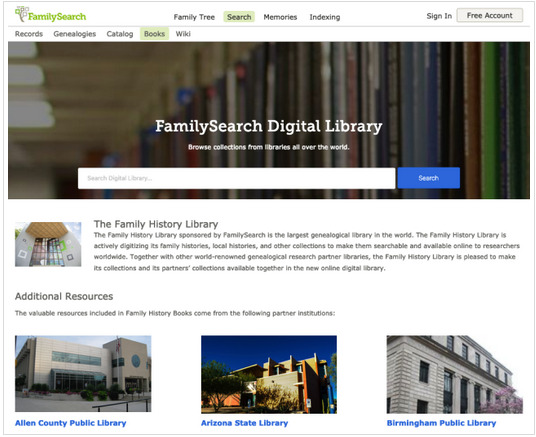
You will find the library in FamilySearch.org. Once you sign in, click Search then click Books. You will see a screen similar to the one above. Before you hit the search box at the top of the screen, scan down the page and see which libraries are part of this project. They include:
The Genealogy Center at the Allen County Public Library
Arizona State Library
Family History Library
Birmingham Public Library
Dallas Public Library
Historical Society of Pennsylvania
Midwest Genealogical Center
Onondaga County Public Library
St. Louis County Library
University of Florida George A. Smathers Libraries

In this example, I searched for “south carolina huguenots” and got 278,409 results. You see two of them here. Notice the Access Level item for the first one is Public (Public Domain) while the second is Protected (still under copyright). There is a Full text results button under each item and in this example, a scanned title page for each. Click on the title page to view a screen with more details about the item.

Since this is a public domain publication, I have a “View All Pages 398 pages” link to open this publication for reading.
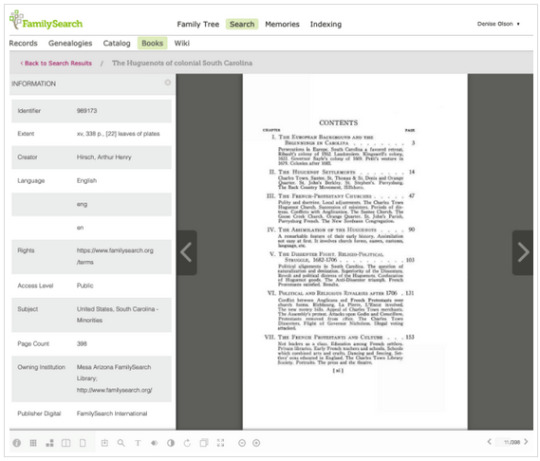
Here’s what the reader screen looks like. Use the arrow buttons to move to the next page or previous page. Notice the icons at the bottom of the screen. They offer many options. Click the box icon with a down arrow in it to download this publication. The magnifying glass icon is used to search the publication. Other icons let you zoom in or zoom out for better viewing. Hover over any icon to view its purpose.
This impressive addition to online archives is a researcher’s delight. Unlike the Internet Archive, not everything in the FamilySearch Digital Library is public domain. You may have limited access or even no access to some of the publications, but don’t let that stop you. Use the details about the publication and WorldCat.org to find a library near you where you can view that book. Happy hunting!
0 notes